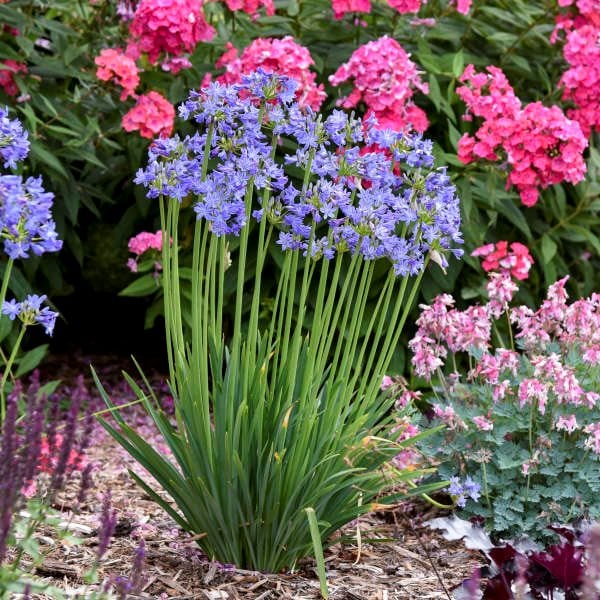Spectacular Agapanthus: Enhancing Your Yard's Beauty
Spectacular Agapanthus: Enhancing Your Yard's Beauty
Blog Article
Grasping the Art of Agapanthus Treatment: Essential Steps for Healthy And Balanced Growth and Vivid Blooms
In the realm of cultivation, the growing of agapanthus stands as a satisfying undertaking for those who seek to nurture these sophisticated flowering plants. With their striking blossoms and graceful vegetation, agapanthus has actually caught the interest of garden enthusiasts worldwide. Nevertheless, attaining ideal growth and lively blossoms requires a nuanced method that encompasses various crucial actions. From picking the right selection to mastering trimming techniques, the trip in the direction of cultivating prospering agapanthus plants is multifaceted and holds the vital to opening the full possibility of these botanical treasures.

Choosing the Right Agapanthus Variety

When selecting the ideal Agapanthus selection for your garden, consider variables such as environment viability, blossom shade, and development habit. In addition, think about the environment in your region to ensure the Agapanthus range you pick can thrive in your particular conditions. Understanding the development practice of various Agapanthus varieties is vital for appropriate placement within your yard.
Perfect Growing Conditions
Thinking about the optimum ecological demands is necessary for successful Agapanthus farming. Agapanthus thrives in well-draining soil with a slightly acidic to neutral pH level. When growing, choose an area that gets full sunshine to partial shade. In hotter climates, giving some mid-day color can avoid scorching of the leaves. Agapanthus plants are sensitive to chilly temperature levels and should be shielded from frost during winter months.
To make certain healthy and balanced growth and vibrant flowers, plant Agapanthus bulbs at a depth of about 2-4 inches and area them 8-12 inches apart. Mulching around the base of the plants helps maintain wetness and subdues weed development.
Watering and Feeding Tips
Maintaining correct dampness degrees and giving necessary nutrients are key elements in the treatment program for Agapanthus plants. When it comes to sprinkling Agapanthus, it is vital to strike an equilibrium. If overwatered, these plants prefer constantly damp dirt yet are at risk to root rot. Throughout the expanding season, water deeply once a week, making sure the soil is well-draining to stop waterlogging. In hotter environments or during durations of drought, even more regular watering may be necessary to maintain the dirt uniformly moist. Nonetheless, lower watering in the winter season to avoid water logged conditions.
Feeding Agapanthus is important for promoting healthy and balanced development and respected blossoms. Apply a well balanced fertilizer, such as a 10-10-10 formula, in the very early springtime as new development emerges. By complying with these watering and feeding suggestions, you can guarantee your Agapanthus plants thrive and create vibrant, lasting blossoms.
Trimming Techniques for Agapanthus
Trimming Agapanthus plants at the proper times and with appropriate techniques is important for keeping their health and promoting optimal growth and blooming. The excellent time to trim Agapanthus is in late winter season or early spring prior to brand-new development emerges.
Deadheading spent flowers can likewise redirect the plant's energy right into producing more blossoms instead than setting seeds. If you want to accumulate seeds for propagation, leave some flowers to fully grown and completely dry on the plant.
Keep in mind to use tidy, sharp devices to make precise cuts and minimize the danger of introducing conditions. Agapanthus. Routine pruning will certainly help keep your Agapanthus looking neat and healthy and balanced while making certain an abundant display screen of stunning blossoms
Taking Care Of Typical Bugs and Illness
After ensuring correct pruning techniques for Agapanthus, view website it is necessary to attend to usual insects and illness that can impact the health and vitality of these plants. Agapanthus plants are typically hardy yet can still succumb particular concerns. One common bug that influences Agapanthus is the Agapanthus gall midge. This little, orange fly lays its eggs in the foliage, resulting in altered development and blossom buds that fall short to open up. To battle this insect, prune and ruin any type of afflicted plant parts and take into consideration utilizing insecticidal soap.
In addition, Agapanthus plants can suffer from origin rot if they are grown in badly draining pipes soil. By being watchful and taking punctual activity versus pests and diseases, you can aid your Agapanthus plants thrive and produce vibrant flowers. Agapanthus.

Verdict
In final thought, understanding the art of agapanthus care involves picking go the right selection, offering ideal planting problems, appropriate watering and fertilizing, ideal trimming methods, and dealing with find more information typical parasites and conditions. By adhering to these essential actions, you can guarantee healthy development and dynamic blossoms for your agapanthus plants. Keep in mind to frequently keep track of and maintain your plants to advertise their total wellness and long life.
To ensure healthy and balanced development and lively blooms, plant Agapanthus light bulbs at a deepness of concerning 2-4 inches and space them 8-12 inches apart. By following these watering and feeding ideas, you can ensure your Agapanthus plants flourish and produce lively, long-lasting blooms.
One usual insect that affects Agapanthus is the Agapanthus gall midget. In addition, Agapanthus plants can endure from root rot if they are planted in badly draining soil. By following these essential steps, you can make sure healthy and balanced growth and lively blooms for your agapanthus plants.
Report this page